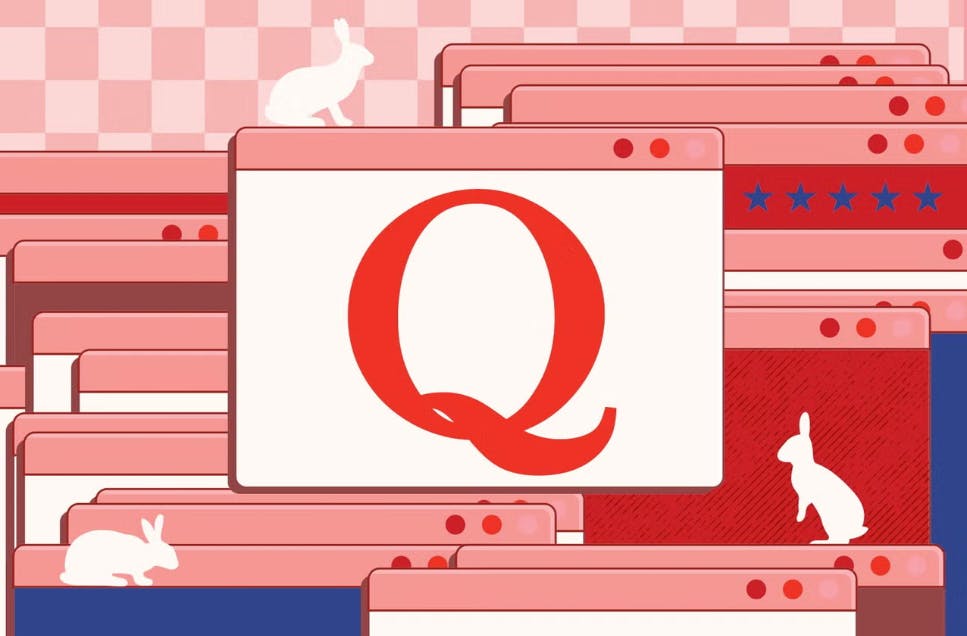QAnon Can’t Be the Scapegoat Anymore


The Pennsylvania man accused of decapitating his father undoubtedly spent time in dark places on the internet. That became abundantly clear when news broke that the man, 32-year-old Justin Mohn, had been arrested after holding up a severed head in a YouTube video and calling for the execution of federal government employees, starting with his own father. In his ramblings, Mohn called on “patriots and militia members” to win their country back from “the globalist, communist takeover of America.”
It’s hard to get to the point of making manifestos on YouTube (let alone broadcasting lethal violence online) without some exposure to certain extreme digital spaces. So it’s easy to see how certain right-wing tabloids jumped to some conclusions in their coverage of this disturbing crime. “QAnon Believer Accused of Beheading Federal Worker Dad Smirks in New Mugshot,” a New York Post headline stated. The U.S. version of the Mirror similarly proclaimed him to be a QAnon adherent, as did the Daily Mail.
The problem is that there’s no evidence Mohn had any connection to QAnon. No reporters have dug up any mention in Mohn’s digital footprint of the group’s trademarks, like “the storm” (Donald Trump’s supposed great coming triumph over a vast pedophilic cabal) or Democrats committing child sacrifices. He used violent right-wing rhetoric, yes. But we can’t ascribe his beliefs to QAnon.
It might sound pedantic to split hairs about the conspiracy theories that drive extremists like Mohn to do despicable things. But as several experts in the world of online extremism told me, making that distinction is important beyond just understanding Mohn’s crime. It’s crucial to grasping and confronting the more expansive problem of political and social extremism in American society today.
To put it another way, it’s tempting to believe that right-wing conspiracy theorists don’t deserve our nuance, that their wackiness shouldn’t demand that we spend any of our precious time on this earth reading up on adrenochrome or frazzledrip. But experts say that labeling everything that reeks of right-wing brain rot as QAnon-affiliated risks obscuring just how much extreme right-wing rhetoric is now coming from much more mainstream sources—including politicians themselves.
QAnon “is perceived as a collection of outrageous bullshit beliefs backed by nonsense,” said Al Jones, the pseudonym for the founder of the Q Origins project, which examines QAnon culture from its earliest days to now. “People see these as fundamentally silly and unserious beliefs and worldviews. They see a Q believer as a yokel or uninformed idiot.”
If you mark any kind of right-wing violence that stems from conspiratorial belief as “QAnon,” Jones said, you risk misunderstanding mainstream right-wing rhetoric as fringe.
Mohn, in the YouTube video, complained about the LGBTQ community, immigrants, and the Black Lives Matter movement. These groups, he said, were working with the federal government (“the deep state”) to allow a “globalist, communist takeover” of the country. His conclusion isn’t a rational one, but it’s also not as fantastical as QAnon’s satanic cabals; his violent act reeked of other, more basic forms of hatred-based conspiracy theories with broader appeal.
“Oftentimes with these violent actors, they just pick and choose from different ideologies and form franken-beliefs—some people call it ‘salad bar extremism,’ ” said Alex Mendela, an associate analyst for Alethea, a company that detects and mitigates mis- and disinformation. “But by saying anyone in this soup of conspiracy theories is QAnon, you’re distorting the threat.”
Read the full story here.